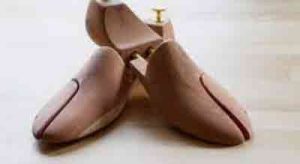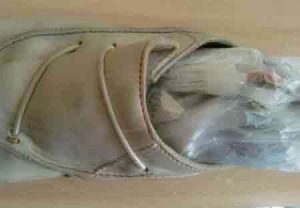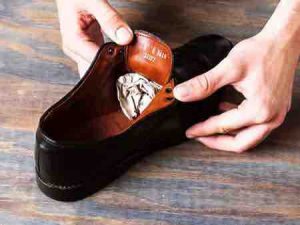No matter how expensive a shoe is, if not properly taken of, it will lose its quality and beauty in a short period.
And one way of ensuring that your shoe lasts for a long period without falling out of shape is by using shoe trees.
If you don’t have a shoe tree, or can’t afford one but need a device that can help you maintain your shoe’s shape and enhance its durability then you do not need to worry cause we will be looking at some shoe tree alternatives you can make from the comfort of your home.

So, without further ado, Let’s get right to it.
Four Shoe Tree Alternatives you can get at home
- Clay
- Plaster
- Newspaper
- Rice
Use of Clay

If you don’t have a shoe tree, you can mold one. To achieve this, you must get clay and a plastic sock cover.
To ease this process, you must endeavor to use easy-to-mold clay and to avoid unwanted odor you should endeavor to use scented clay to add fragrance to your shoe whenever it is used.
When you get this type of clay, put it into the plastic shoe cover and carefully fit it into the shoe. This plastic shoe cover prevents the clay from sticking inside the shoe.
After fitting the clay into the shoe, press it firmly to enable it to take the shoe’s shape and in the process making it look like a foot in a shoe.
And when you are sure that the clay in it has filled up the entire shoe space, pull it out slowly and carefully, in a way that the clay in the plastic sock cover won’t lose the shape it has gained.
Now, you need to dry the clay so that it can retain the shape of the foot and become tough and unbreakable. You can dry it by placing it under the sun for a certain period and then use it as a shoe tree afterward.
The decision of either removing the plastic cover or not at this point is left for you.
The durability of this molded shoe tree depends on the quality of clay used, but to avoid regrets you can mold a new one as time goes on, hence the process involved is an easy one.
Use of Plaster
Unlike in the previous method where clay was used, this method involves the use of plaster and water and also a plastic sock cover.
First of all, you get an object like a plastic box where you can mix plaster and water. After you have mixed them in the box, fill them into the plastic sock cover and fit them into the shoe.
Let it stay inside the shoe until it starts getting hard. Now, slightly and carefully remove it from the shoe and sundry it. You can now remove the plastic sock cover and let it dry completely.
Allow it to stay under the sun for at least 24 hours and then it will be ready for use. You decide to paint it at this point and give it a classy look.
With this structure, you don’t have to worry about your shoe losing shape because it provides the perfect structure for your shoe when you don’t have them on.
However, you must endeavor to provide breathable space while building it so that it can allow the moisture in the shoe to dry up and hence enhance its durability.
Use Of Newspaper

Did you know your newspaper could be a great moisture-absorbing alternative to a shoe tree?
This method is without a doubt one of the most popular and cheapest alternatives to a shoe tree because of its availability, recyclability, and conformity to various shoe shapes and sizes.
All you need to set up this structure is a newspaper (whether old or new), and a plastic freezer bag or a plastic sock cover.
First, you must join the newspapers and wrap them. While wrapping them, you must ensure that they are shaped in a way that can fit into the shoe.
You can then insert them into the shoe to confirm if it is a perfect size and adjust or compress them to fit if it’s not.
Once you get the perfect size for the first shoe, you must then repeat the same process for another leg.
Secondly, you must place the perfectly wrapped newspaper into the plastic freezer bag or plastic sock cover.
These bags help to keep these newspapers as tight as possible, prevent them from staining the shoes when inserted, and also help keep them in shape.
However, before fixing these bags in your shoe, you must discard them of any atom of air to prevent them from getting overly big, then fix the newspapers inside them and tie their handles.
After the newspaper absorbs moisture from your shoe, you can choose between discarding them or sun drying them and using them later.
Despite its ability to absorb moisture from a shoe, the downside of using newspapers as an alternative to a shoe tree is its inability to maintain a shoe’s shape when it is pulled off.
Furthermore, due to its folded and unbalanced structure, it’s likely to lose shape once in while, so you might need to reassemble them as time goes on.
Use Of Rice
Another alternative way of absorbing moisture from your shoe is by fixing a sock filled with rice in them.
Apart from the nutrient that rice provides to the body when eaten, it is also a great drying agent and moisture absorber.
Unlike other grains, rice absorbs moisture but doesn’t release it back unless it is placed in a less humid environment afterward.
So, you can simply place the sock filled with rice in your shoe for a particular period and then remove it and place it in a dry environment for it to release the moisture it has absorbed.
What Are Shoe Trees?
Shoe trees are foot-shaped devices that are fixed inside a shoe to maintain its shape when it’s not worn and ensure its durability.
These devices are made with either a two-piece or three-piece design. In the two-piece design, it has a forefoot-like front design and a heel-like back design which is accompanied by a spring that helps it fit into various shoe sizes.
Meanwhile, in the three-piece design, the forefoot-like front design is divided from its center into two halves and attached with a spring which makes it adjustable, while its heel-like section is designed with a rounded shape compared to the two-piece design.
In addition, specially designed shoe trees are also produced by top shoe brands like Gucci and Prada and sent as a bonus package for customers who patronize their expensive designer shoes.
Cedar, which is a type of wood, is the most commonly used material in the production of shoe trees due to its ability to remove moisture from shoes and leave an appealing smell on them when removed.
However, due to the lighter nature of plastic materials, shoe trees made from them are most preferred by travelers and people who move around with their shoes. Shoe trees made from this material are also cheaper.
Read our related topics on shoe trees:
Why Are Shoe Trees Important?
First of all, they absorb moisture from your shoe hence preserving the health of both your shoe and your feet.
Putting your shoe on for hours causes your feet to generate sweat which is absorbed by your shoe’s lining causing it to rot, your shoe to smell terrible, and its materials to crack over a certain period.
Sweating of your feet could also put your feet at risk of being affected by fungus, bacteria, or infection.
Second, they help your shoes maintain their shapes and prevent them from developing creases.
Although creasing is a necessity when you put on shoes for a particular period, using these devices on your shoes helps to reduce the appearance of these creases on them as they age.
Conclusion on shoe tree alternatives
Without a doubt, the use of shoe trees on your shoes will not only help your shoe last for long but also maintain its shape but in its absence, you can use any of these alternatives.
Remember that it is cheaper to purchase a shoe tree to enhance your shoe’s durability than to spend money buying different shoes due to the spoilage of the ones you bought earlier.
This page may contain affiliate links.
To support the content and the knowledge I share here, I earn from qualifying purchases from Amazon at no extra cost to you.
